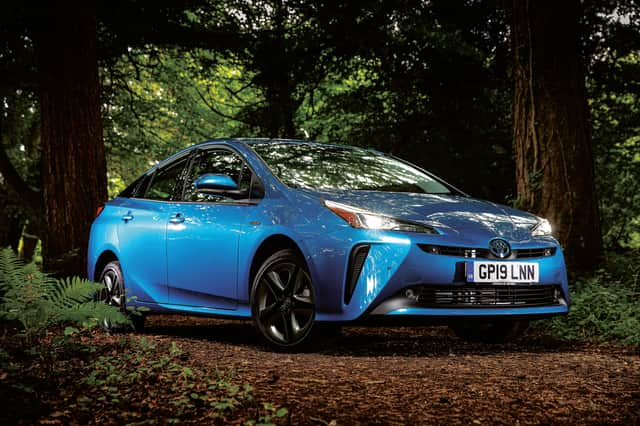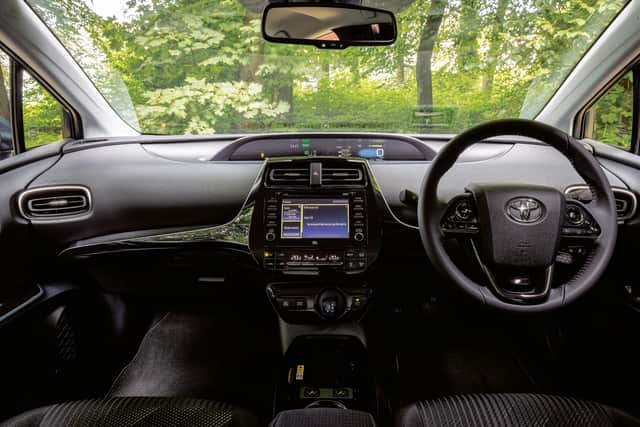Review: Toyota Prius AWD-i


Toyota was a pioneer in production of hybrids – those vehicles incorporating an electric motor with a petrol or diesel engine. They improve fuel economy while decreasing toxic exhaust emissions. Toyota leads the market.
The Prius petrol/electric saloon was the first mass production hybrid, arriving in Japan in 1997 and the wider world from 2000. The body became more practical and aerodynamic in 2003 with the adoption of a fastback tailgate. Styling came from its California studio, with the state’s celebrities adopting and endorsing its ecological insight. By 2009 aluminium and synthetics made from plant fibres were being used in its construction.
Advertisement
Hide AdAdvertisement
Hide AdThe current “look” came last year and sits on the lower global chassis. There is also a mains-charging plug-in version (PHEV) which gives a limited range on pure battery power. Tested here is the plain hybrid, which charges the battery during the car’s progress through braking, forward motion and the petrol engine.


Our car has the optional all-wheel-drive system which will appeal to hill folk or others afflicted by slippery roads or just keen on maximum traction. This adds an additional motor to drive the rear wheels. Both front and rear motors get their power from the high capacity battery which sits across the car under the rear seat. A fan keeps it cool and it is of course isolated from contact with passengers.
The system meshes seamlessly with a 1.8-litre petrol engine and drives the wheels through an automatic gearbox. You can just drive it, allowing the petrol and electric power to flow to the wheels. This power distribution is affected by how and where you are driving. A light throttle will allow the car to waft along, with little drain on the electric system. Pushing on, or climbing hills, and the battery will boost the power in an instant. Braking, or decelerating or coasting downhill replenishes the battery reserves.
Unlike a PHEV, a normal hybrid has a limited range on pure electric power. You can isolate this using an Electric Vehicle button but much over 20mph will bring in the petrol engine. However, you have the option for a low-speed, pollution-free drive in sensitive areas, such as schools.
You can glide by on virtually zero carbon, zero noise, zero nitrous oxides, maybe, too, some appraisal for its sleek shape.
This is one of the most enjoyable cars I have driven this month, last month, in ages. The lower riding height and clean slipstream combine with a surprising shove from the three engines. The mid-range response is almost immediate and the effect belies the modest power ratings.
The handling is first rate, with fine grip and balance, and always the reward of the high mpg figures in plain sight. There is a hum from the Yokohama BluEarth tyres – noticed because the rest of the Prius is quiet.
The instruments are on a shallow panel which runs across the top of the dashboard at eye level, just below the windscreen. The area behind the steering wheel is blank. This layout suits either left or right steering. You have a small navigation and information screen in the centre. A head-up display on the windscreen in front of the driver repeats the navigation guidance, shows power reserves and turns the speed limit red if you exceed it.
Advertisement
Hide AdAdvertisement
Hide AdThis is a roomy five-seater, with folding rear seats to extend the shallow luggage area under the liftback tailgate.
The controls are simple. A button switches the system on, and a short flick of the stubby selector in the central stack engages drive or reverse. Most of the time you will set off on electric power.
Prius is one of several hybrids from Toyota, which is moving rapidly away from single-engined vehicles. It is a popular taxi, with station forecourts proving their appeal. The longer Prius+ seats up to seven, or with the rear seats flat carries more luggage than the “saloon”. Check also the estate version of the UK-built Corolla. Coming, the new Yaris hybrid.
Mandatory showroom closures mean you can’t buy cars at the moment but you can watch how this week’s test car is built here: https://www.youtube.com/watch?v=t0E66vaiXeg
Comments
Want to join the conversation? Please or to comment on this article.